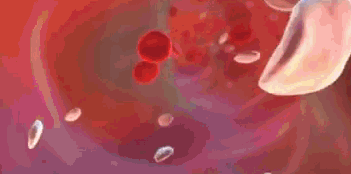Blood clotting and platelets
Platelets are tiny fragments
of membrane-enclosed cytoplasm. They do not have a nucleus and their
life span is only ten days. Their function is to stop bleeding. They
do this in two ways, they physically plug openings in blood vessels
and they release chemicals that promote clotting.
-
Within 2 seconds of a blood vessel been cut, the wall of the vessel contracts in a muscular spasm. This initially slows the flow of blood through the wound. The platelets respond quickly by attaching themselves to collagen fibers which are exposed as a result of damage to the vessel's wall. The attached platelets release a chemical which makes platelets sticky and also causes other platelets, in the area, to become activated and release the same chemical. Once activated the platelets change in morphology from an oval disk to an amorphous form with finger-like projections. As blood continues to flow through the wound more platelets are brought in. The increase in the number of sticky platelets near the wound creates a physical plug.
A permanent blood clot begins
to form 20 seconds after the wound was inflicted. The formation of a blood
clot is extremely complex, but a simple explanation will be given here.
As a response to damaged tissue certain chemicals are released into the
blood. These chemicals activate molecules present in the blood called
thrombin. Thrombin, once activated, goes about
finding a protein called fibrinogen and causing
it to link together into long fibre-like threads called fibrin.
These insoluble fibrin threads form a web trapping red blood cells and
platelets and further increasing the strength of the clot.

Clotting has evolved as a life saving mechanism. This life saving mechanism however, can go horribly wrong when undesirable clotting takes place in blood vessels. The internal lining of the blood vessel wall is smooth and lined with proteins(negative charged) that repel platelets and chemicals that promote clotting.
Sometimes the wall of the blood
vessel becomes rough, due to arteriosclerosis
or hardening of the arteries. Smokers are 6 times more likely to develop
arteriosclerosis than non-smokers. Diet is also an important contributor
to the onset of arteriosclerosis. People with a fatty diet are more likely
to suffer this condition than people with a low fat diet.
A blood clot may become so large that it blocks the artery, starving vital
organs of blood and causing death.
Present in the blood are chemicals known as anticoagulants. These chemicals help to prevent unnecessary clotting from taking place. Two such chemicals are plasmin and heparin. Plasmin slowly dissolves fibrin. This is helpful both in dissolving unwanted clots and also in the natural healing process of major external wounds. Heparin is released by certain types of white blood cells(basophils) and acts to inactivate the chemicals that promote the conversion of fibrinogen to insoluble fibrin. Although heparin is used clinically it is a major constituent of rat poison.
A platelet is a
Fibrinogen is a
Fibrin is a
What is one of the many factors that stimulates platelet acitvation
The initial plug that forms to seal an opening in a blood vessel is mostly composed of
Which is the correct sequence of events to stop bleeding?